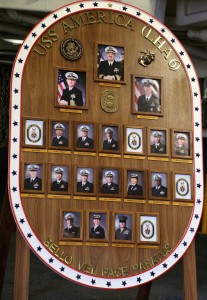2014-06-13 The USS America is going to sea mid-July 2014.
During a visit to the ship on June 12, 2014, Captain Hall, the CO of LHA-6, discussed the ship and its contribution.

A key way to look at the ship is to understand that it is the first large deck amphibious ship designed to support 21st century USMC aviation and integrated Ground Combat Element innovation.
As such, it is a 21st century assault ship, and able to operate as the lead ship in an assault or presence operation.
The USMC is the only tiltrotar-enabled assault force in the world; and the USS America has been designed to support such a capability and to prepare for the introduction of the F-35B as a key element for doing 21st century style presence and assault operations.
A key way to understand the ship is that the flight deck is of the same size as LHA’s before it.
But the next two decks are very different.
The hangar deck immediately below the flight allows maintenance to be done out of the weather and to prepare aircraft for flight deck, to enhance operational tempo.
Given the ship is going to operate in the Pacific, this is no small change!
And directly below the hangar deck is the intermediate area, which has been designed to support the two decks directly above it.

There are four aviation elevators capable of carrying 12,000-pound loads; and passageways designed for pallet-sized loads, to enable standard pallets to be moved around the ship; and the work areas are very large for maintenance and operations.
The ship is designed for a very different ops tempo than earlier LHAs and to be able be able to operate much further from the shore to engage in amphibious assault.
The ship can operate with its long-range aviation assets to influence events much further than the Navy-Marine Corps team could operate before.
And the fleet contribution of the LHA-6 will be significant in others ways.
The Osprey is at the heart of modern USMC assault operations; the USN in acquiring Ospreys for their large deck carriers can leverage the at sea repair and maintenance facilities aboard the USS America class of ships as well.
The ship carries more than twice the fuel of a traditional LHA, which allows it support, its self and its ARG-MEU group more effectively; has fuel available to support ashore operations for embarked Marines or to support forces ashore working in humanitarian or disaster relief operations.
In this video slice from the interview, Captain Hall focuses on the support aspects of the ship.
The full interview will be published in the near future.
The ship plus the aircraft provide a very different environment within which the USN-USMC team will build out innovation across the spectrum of operations, but able to operate at greater distance away for objectives areas.
There is a “lot of synergy here,” added Captain Hall.
Credit Video: Second Line of Defense

